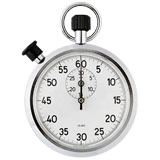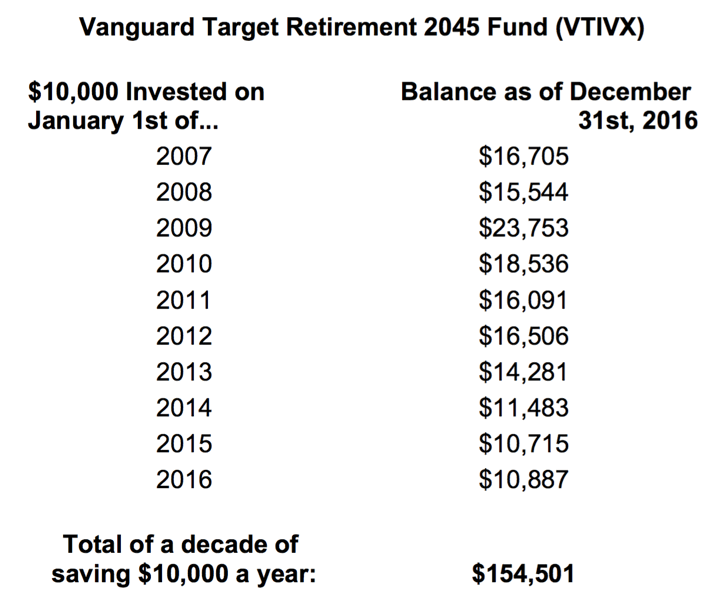
Instead of just looking at one year of returns, here’s an annual exercise that helps you look at the bigger picture. You may know the 10-year historical return of the S&P 500, but most of us didn’t just invest a big lump sum of money in 2007, and most of us don’t just invest in the S&P 500.
Investment benchmark. There are many possible choices for an investment benchmark, but I chose the Vanguard Target Retirement 2045 Fund. This all-in-one fund is low-cost, highly-diversified, and available in many employer retirement plans as well open to anyone with an IRA. In the early accumulation phase, this fund is 90% stocks (both domestic and international) and 10% bonds (investment-grade domestic and international). I think it’s a solid default choice where you could easily do worse over the long run.
Investment amount. For the last decade, the maximum allowable contribution to a Traditional or Roth IRA has been roughly $5,000 per person. (It was $4k in 2007, but has been $5k or higher since.) That means a couple could put away at least $10,000 a year in tax-advantaged accounts. If you have a household income of $67,000, then $10,000 is right at the 15% savings rate mark.
A decade of real-world savings. To create a simple-yet-realistic scenario, what would have happened if you put $10,000 a year into the Vanguard Target Retirement 2045 Fund, every year, for the past 10 years. You’d have put in $100,000 over time, but in more manageable increments. With the handy tools at Morningstar and a quick Google spreadsheet, we get this:

In this case, I would say that ending up with a gain of over $50,000 for every $10k annual investment is nothing to sneeze at. If you put in $20k every year, your gains would have been over $100,000. Some of that money was invested right before the crash in 2008, and some has only been in the market for a few years. Not every year will have turned out to be a great year to invest, but taking it all together provides a more calm, balanced picture.
 The Best Credit Card Bonus Offers – 2025
The Best Credit Card Bonus Offers – 2025 Big List of Free Stocks from Brokerage Apps
Big List of Free Stocks from Brokerage Apps Best Interest Rates on Cash - 2025
Best Interest Rates on Cash - 2025 Free Credit Scores x 3 + Free Credit Monitoring
Free Credit Scores x 3 + Free Credit Monitoring Best No Fee 0% APR Balance Transfer Offers
Best No Fee 0% APR Balance Transfer Offers Little-Known Cellular Data Plans That Can Save Big Money
Little-Known Cellular Data Plans That Can Save Big Money How To Haggle Your Cable or Direct TV Bill
How To Haggle Your Cable or Direct TV Bill Big List of Free Consumer Data Reports (Credit, Rent, Work)
Big List of Free Consumer Data Reports (Credit, Rent, Work)
That’s an interesting way to look at it. It definitely pays off to invest and evenly work it out over the years. This heaps spread the risk but also the reward. How exciting
Just FYI, the internal rate of return (IRR), which is technically the discount rate that sets the present value of all of those $10k investments equal to the present value of the ultimate $154k value, was 7.8%. This is essentially the blended rate at which those investments compounded given how long they were invested. Not too shabby, especially given that the global financial crisis was right in the middle of that decade.
Here are the individual annualized rates of return for each year’s investment through 12/31/16: 2007: 5.26%; 2008: 5.02%; 2009: 11.42%; 2010: 9.21%; 2011: 8.25%; 2012: 10.54%; 2013: 9.32%; 2014: 4.72%; 2015: 3.51%; 2016: 8.87%.
Jonathan, what if instead of DCA’ing someone would have invested 100,000 in 200? What would have been the returns?
Thanks
200 what? Just add a zero to the appropriate row. $100k invested in 2007 would be $167,050 at the end of 2016 for example.